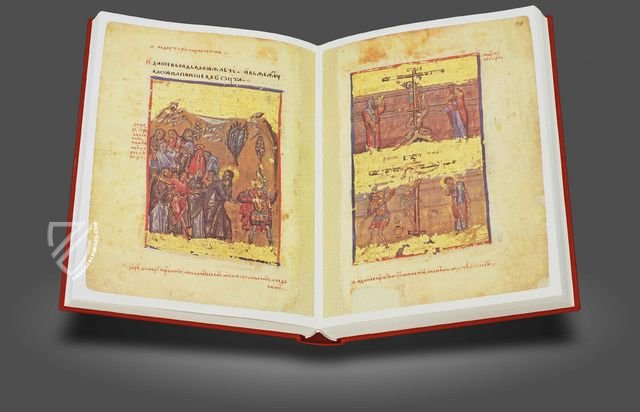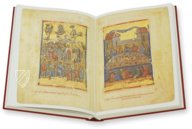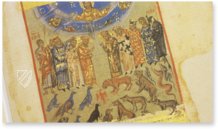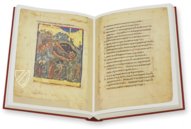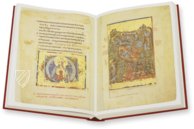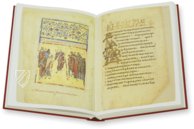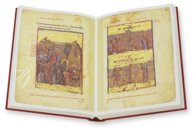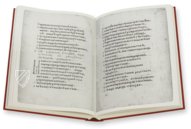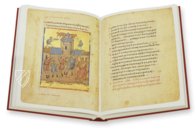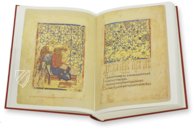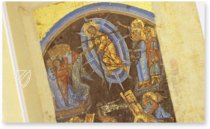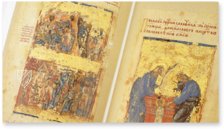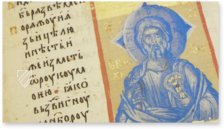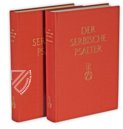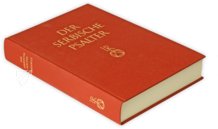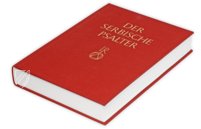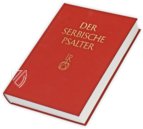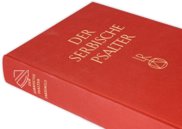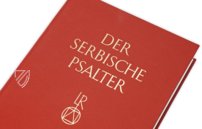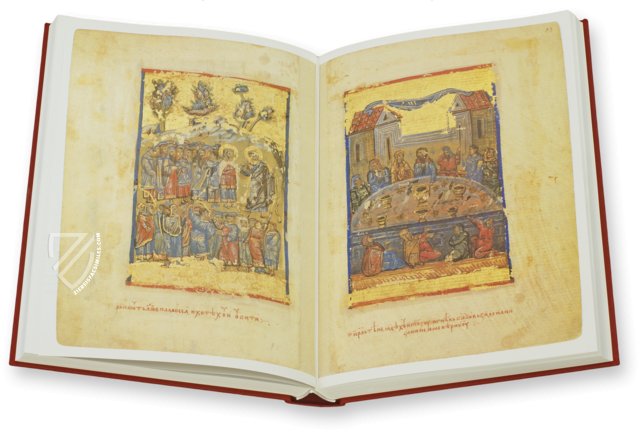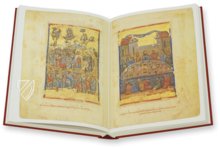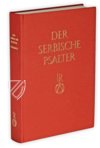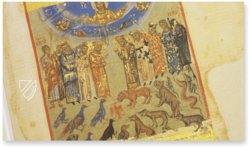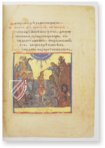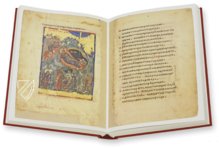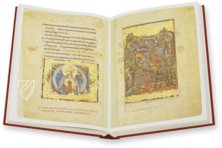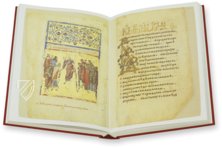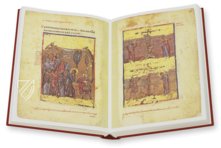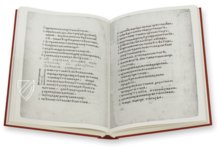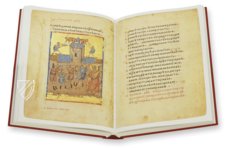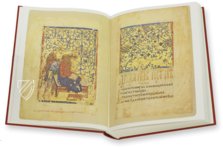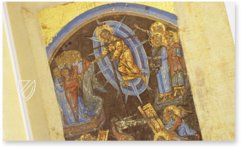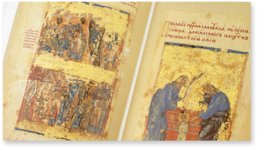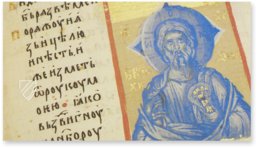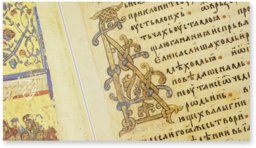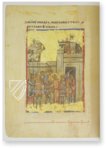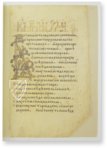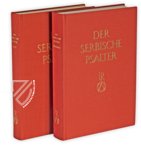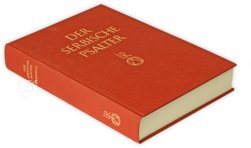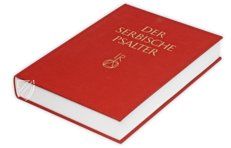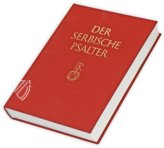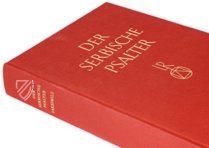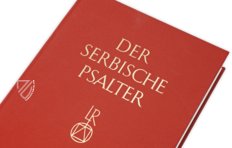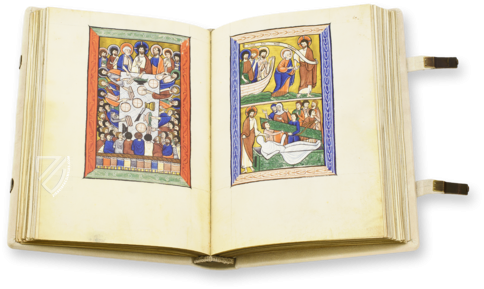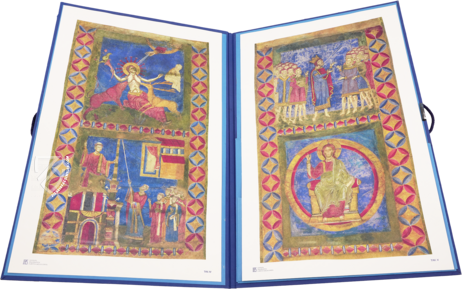Munich Serbian Psalter
(1,000€ - 3,000€)
The Munich Serbian Psalter was created by talented but unknown artists in late 14th century Serbia and is considered the most important testimony to medieval Serbian book art. Commissioned by the Serbian prince and saint Lazar Hrebeljanović or his son Stefan Lazarević, the codex features extensive and elaborate book decoration: A total of 148 mostly full-page miniatures featuring Byzantine influences shine against a precious gold background and illustrate the psalm texts with scenes from the New and Old Testaments. The important treasure of Slavic book illumination was accordingly much sought after throughout its existence and passed through many hands. After it came as booty to Bavaria during the Ottoman Wars in the 17th century, it finally found its way to Munich in the course of secularisation, where it is still kept today in the Bavarian State Library.
Munich Serbian Psalter
The impressive Munich Serbian Psalter, which is housed today in the Bavarian State Library, is the most important evidence of Serbian illumination in the Middle Ages. The Serbian illuminated manuscript originated from the Balkans at the end of the 14th century and has extensive pictorial adornment: altogether, 148 mostly-full-page miniatures on a splendid gold background illustrate the Old and New Testaments in addition to the Psalms. As such a significant treasure of Slavic illumination, the codex was highly coveted and can look back on an eventful provenance.
A Princely Commission
The impressive Serbian manuscript, known as the Munich Serbian Psalter, was probably the commission of the Serbian Prince Lazar Hrebeljanović or his son Stefan Lazarević. Hrebeljanović (ca. 1329–1389) is considered to be a significant Serbian feudal lord, famous above all for his struggles against the Ottomans. The Prince of Serbia fell in the Battle of Amselfeld and was sainted in the Serbian Orthodox Church for his service to his fatherland. Stefan Lazarević (1377–1427), his son and heir, is famous as a patron of art and literature, Serbian literature was founded at his court inter alia.
Slavic Art on a Splendid Gold Background
As a princely commission, the psalter presents itself in overflowing splendor. The visual adornment comprises 148 miniatures on 229 pages measuring 28 x 19.7 cm. These mostly-full-page depictions in blue and red frames on gold backgrounds illustrate the text of the manuscript in the Slavic style with distinct Byzantine influences: the Old and New Testaments, the Psalms, and doxologies in Serbian. The spectrum of themes ranges thereby from the Good Samaritan to the birth of Christ to the Genesis story of Adam and Eve. As a result, the Munich Serbian Psalter is the most comprehensive illuminated manuscript of Serbian Orthodoxy.
The Way from Serbia to Bavaria
The psalter found itself in the possession of the princely Serbian Branković family and reached the Privina Glava Monastery on Fruška Gora mountain (Srem) by the 17th century at the latest. During the turmoil of the Turkish Wars, the manuscript came as plunder to Bavaria and into the possession of Wolfgang Heinrich von Gemell zu Flischbach, who gifted the codex to Gotteszell Abbey in Lower Bavaria. It found its way from there to St. Emmeram in Regensburg in 1782 and finally came to Munich in 1810 during the course of Secularization. Stored under the shelf mark Codex Monacensis Slavicus 4, today the Munich Serbian Psalteris one of the treasures of the Bayerischen Staatsbibliothek.
Codicology
- Alternative Titles
- Münchner Serbischer Psalter
Serbischer Psalter
Psautier Serbe de Munich - Type
- Manuscript on paper
- Size / Format
- 229 pages / 28.0 × 19.7 cm
- Origin
- Serbia
- Date
- Late 14th century
- Epochs
- Genre
- Script
- Uncial
- Illustrations
- 148 miniatures, which often occupy whole pages, painted on a gold background and framed by red and blue lines
- Content
- The Psalms, the canticles, and the Akathist to the Theotokos
- Patron
- Prince Lazar Hrebeljanović of Serbia (c. 1329 – June 15th 1389) or his son Stefan Lazarević, the Tall (c. 1377 – July 19th 1427)
- Previous Owners
- Moravian Serbia and Serbian Despotate (14th–15th centuries)
Privina Glava Monastery in Syrmia (17th century)
Wolfgang Heinrich of Gemell zu Flischbach
Gotteszell Monastery in the Bavarian Forest (1689–1782)
St Emmeram's Monastery, Regensburg (1782 – c. 1800)
Munich Serbian Psalter
Baptism of Jesus
As a group of angels look on with anticipation, Jesus is shown stripped to the waste as John the Baptist reaches out to dunk his head underwater: “It came to pass in those days that Jesus came from Nazareth of Galilee, and was baptized by John in the Jordan. And immediately, coming up from the water, He saw the heavens parting and the Spirit descending upon Him like a dove. Then a voice came from heaven, ‘You are My beloved Son, in whom I am well pleased’.” (Mark 1:9-11)
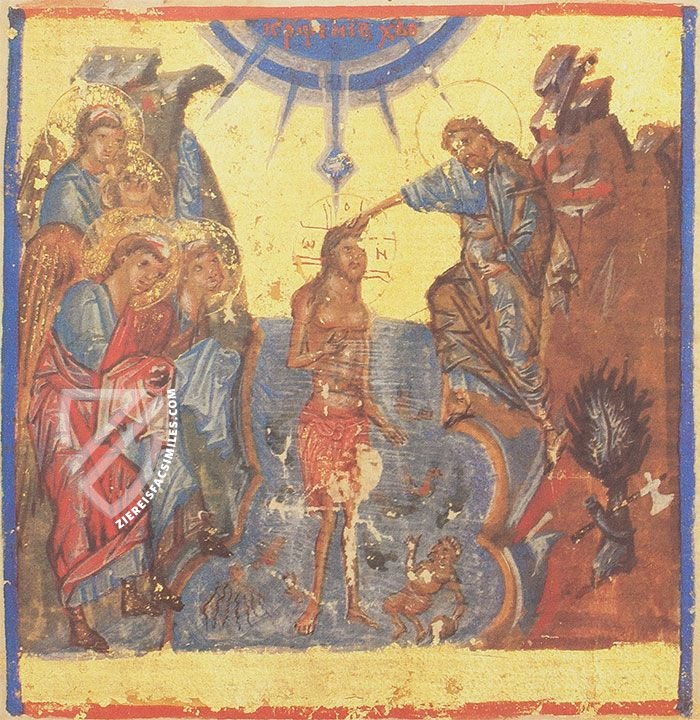
Munich Serbian Psalter
Psalm 55 / David in Gath
Fleeing from the murderous jealousy of King Saul, David fled first to Nob before coming to Gath, the Philistine city of Goliath. He is detained there because of uncertainty concerning his loyalty. The caption of this miniature reads “The Gentiles seized David, handcuffed him, and locked him in the city of Gath.”
This manuscript’s Byzantine influence is immediately discernible from the burnished gold leaf background, standardized faces, and expressive gestures in this miniature. David is depicted with a halo and wearing a long robe of red and gold with his hands bound. He is seized by soldiers wearing either scale or lamellar armor, also depicted with gold leaf, and is pictured imprisoned in a tower above the walls, resting his head on his hand.
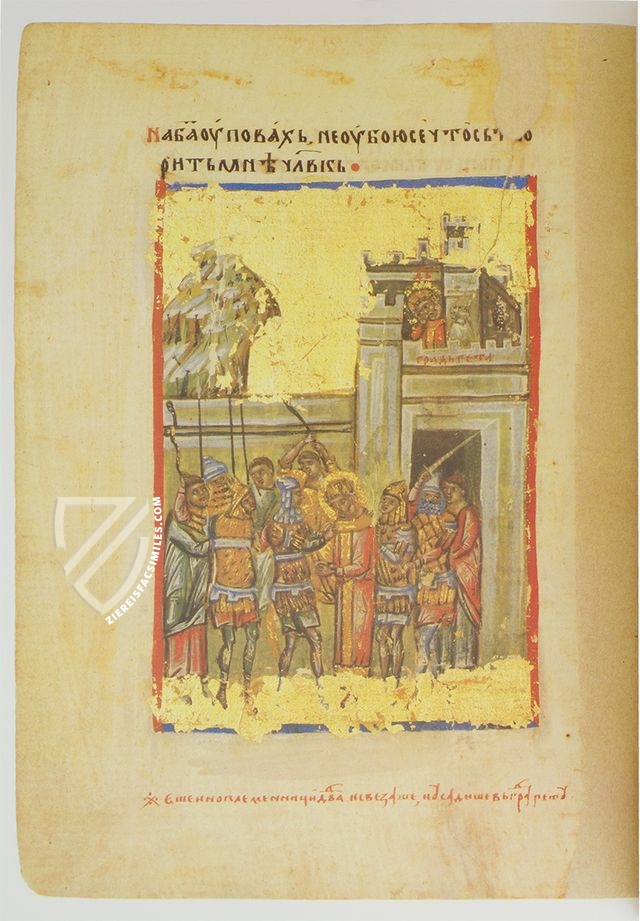
#1 Münchner Serbischer Psalter
Language: German
(1,000€ - 3,000€)
- Treatises / Secular Books
- Apocalypses / Beatus
- Astronomy / Astrology
- Bestiaries
- Bibles / Gospels
- Chronicles / History / Law
- Geography / Maps
- Saints' Lives
- Islam / Oriental
- Judaism / Hebrew
- Single Leaf Collections
- Leonardo da Vinci
- Literature / Poetry
- Liturgical Manuscripts
- Medicine / Botany / Alchemy
- Music
- Mythology / Prophecies
- Psalters
- Other Religious Books
- Games / Hunting
- Private Devotion Books
- Other Genres
- Afghanistan
- Armenia
- Austria
- Belgium
- Belize
- Bosnia and Herzegovina
- China
- Colombia
- Costa Rica
- Croatia
- Cyprus
- Czech Republic
- Denmark
- Egypt
- El Salvador
- Ethiopia
- France
- Germany
- Greece
- Guatemala
- Honduras
- Hungary
- India
- Iran
- Iraq
- Israel
- Italy
- Japan
- Jordan
- Kazakhstan
- Kyrgyzstan
- Lebanon
- Liechtenstein
- Luxembourg
- Mexico
- Morocco
- Netherlands
- Palestine
- Panama
- Peru
- Poland
- Portugal
- Romania
- Russia
- Serbia
- Spain
- Sri Lanka
- Sweden
- Switzerland
- Syria
- Tajikistan
- Turkey
- Turkmenistan
- Ukraine
- United Kingdom
- United States
- Uzbekistan
- Vatican City
- A. Oosthoek, van Holkema & Warendorf
- Aboca Museum
- Ajuntament de Valencia
- Akademie Verlag
- Akademische Druck- u. Verlagsanstalt (ADEVA)
- Aldo Ausilio Editore - Bottega d’Erasmo
- Alecto Historical Editions
- Alkuin Verlag
- Almqvist & Wiksell
- Amilcare Pizzi
- Andreas & Andreas Verlagsbuchhandlung
- Archa 90
- Archiv Verlag
- Archivi Edizioni
- Arnold Verlag
- ARS
- Ars Magna
- ArtCodex
- AyN Ediciones
- Azimuth Editions
- Badenia Verlag
- Bärenreiter-Verlag
- Belser Verlag
- Belser Verlag / WK Wertkontor
- Benziger Verlag
- Bernardinum Wydawnictwo
- BiblioGemma
- Biblioteca Apostolica Vaticana (Vaticanstadt, Vaticanstadt)
- Bibliotheca Palatina Faksimile Verlag
- Bibliotheca Rara
- Boydell & Brewer
- Bramante Edizioni
- Bredius Genootschap
- Brepols Publishers
- British Library
- C. Weckesser
- Caixa Catalunya
- Canesi
- CAPSA, Ars Scriptoria
- Caratzas Brothers, Publishers
- Carus Verlag
- Casamassima Libri
- Centrum Cartographie Verlag GmbH
- Chavane Verlag
- Christian Brandstätter Verlag
- Circulo Cientifico
- Club Bibliófilo Versol
- Club du Livre
- CM Editores
- Collegium Graphicum
- Collezione Apocrifa Da Vinci
- Comissão Nacional para as Comemorações dos Descobrimentos Portugueses
- Coron Verlag
- Corvina
- CTHS
- D. S. Brewer
- Damon
- De Agostini/UTET
- De Nederlandsche Boekhandel
- De Schutter
- Deuschle & Stemmle
- Deutscher Verlag für Kunstwissenschaft
- DIAMM
- Droz
- E. Schreiber Graphische Kunstanstalten
- Ediciones Boreal
- Ediciones Grial
- Ediclube
- Edições Inapa
- Edilan
- Editalia
- Edition Deuschle
- Edition Georg Popp
- Edition Leipzig
- Edition Libri Illustri
- Editiones Reales Sitios S. L.
- Éditions de l'Oiseau Lyre
- Editions Medicina Rara
- Editorial Casariego
- Editorial Mintzoa
- Editrice Antenore
- Editrice Velar
- Edizioni Edison
- Egeria, S.L.
- Eikon Editores
- Electa
- Emery Walker Limited
- Enciclopèdia Catalana
- Eos-Verlag
- Ephesus Publishing
- Ernst Battenberg
- Eugrammia Press
- Extraordinary Editions
- Fackelverlag
- Facsimila Art & Edition
- Facsimile Editions Ltd.
- Facsimilia Art & Edition Ebert KG
- Faksimile Verlag
- Feuermann Verlag
- Folger Shakespeare Library
- Franco Cosimo Panini Editore
- Friedrich Wittig Verlag
- Fundación Hullera Vasco-Leonesa
- G. Braziller
- Gabriele Mazzotta Editore
- Gebr. Mann Verlag
- Gesellschaft für graphische Industrie
- Getty Research Institute
- Giovanni Domenico de Rossi
- Giunti Editore
- Graffiti
- Grafica European Center of Fine Arts
- Guido Pressler
- Guillermo Blazquez
- Gustav Kiepenheuer
- H. N. Abrams
- Harrassowitz
- Harvard University Press
- Helikon
- Hendrickson Publishers
- Henning Oppermann
- Herder Verlag
- Hes & De Graaf Publishers
- Hoepli
- Holbein-Verlag
- Houghton Library
- Hugo Schmidt Verlag
- Idion Verlag
- Il Bulino, edizioni d'arte
- ILte
- Imago
- Insel Verlag
- Insel-Verlag Anton Kippenberger
- Instituto de Estudios Altoaragoneses
- Instituto Nacional de Antropología e Historia
- Introligatornia Budnik Jerzy
- Istituto dell'Enciclopedia Italiana - Treccani
- Istituto Ellenico di Studi Bizantini e Postbizantini
- Istituto Geografico De Agostini
- Istituto Poligrafico e Zecca dello Stato
- Italarte Art Establishments
- Jan Thorbecke Verlag
- Johnson Reprint Corporation
- Josef Stocker
- Josef Stocker-Schmid
- Jugoslavija
- Karl W. Hiersemann
- Kasper Straube
- Kaydeda Ediciones
- Kindler Verlag / Coron Verlag
- Kodansha International Ltd.
- Konrad Kölbl Verlag
- Kurt Wolff Verlag
- La Liberia dello Stato
- La Linea Editrice
- La Meta Editore
- Lambert Schneider
- Landeskreditbank Baden-Württemberg
- Leo S. Olschki
- Les Incunables
- Liber Artis
- Library of Congress
- Libreria Musicale Italiana
- Lichtdruck
- Lito Immagine Editore
- Lumen Artis
- Lund Humphries
- M. Moleiro Editor
- Maison des Sciences de l'homme et de la société de Poitiers
- Manuscriptum
- Martinus Nijhoff
- Maruzen-Yushodo Co. Ltd.
- MASA
- Massada Publishers
- McGraw-Hill
- Metropolitan Museum of Art
- Militos
- Millennium Liber
- Müller & Schindler
- Nahar - Stavit
- Nahar and Steimatzky
- National Library of Wales
- Neri Pozza
- Nova Charta
- Oceanum Verlag
- Odeon
- Orbis Mediaevalis
- Orbis Pictus
- Österreichische Staatsdruckerei
- Oxford University Press
- Pageant Books
- Parzellers Buchverlag
- Patrimonio Ediciones
- Pattloch Verlag
- PIAF
- Pieper Verlag
- Plon-Nourrit et cie
- Poligrafiche Bolis
- Presses Universitaires de Strasbourg
- Prestel Verlag
- Princeton University Press
- Prisma Verlag
- Priuli & Verlucca, editori
- Pro Sport Verlag
- Propyläen Verlag
- Pytheas Books
- Quaternio Verlag Luzern
- Reales Sitios
- Recht-Verlag
- Reichert Verlag
- Reichsdruckerei
- Reprint Verlag
- Riehn & Reusch
- Roberto Vattori Editore
- Rosenkilde and Bagger
- Roxburghe Club
- Salerno Editrice
- Saltellus Press
- Sandoz
- Sarajevo Svjetlost
- Schöck ArtPrint Kft.
- Schulsinger Brothers
- Scolar Press
- Scrinium
- Scripta Maneant
- Scriptorium
- Shazar
- Siloé, arte y bibliofilia
- SISMEL - Edizioni del Galluzzo
- Sociedad Mexicana de Antropología
- Société des Bibliophiles & Iconophiles de Belgique
- Soncin Publishing
- Sorli Ediciones
- Stainer and Bell
- Studer
- Styria Verlag
- Sumptibus Pragopress
- Szegedi Tudomànyegyetem
- Taberna Libraria
- Tarshish Books
- Taschen
- Tempus Libri
- Testimonio Compañía Editorial
- Thames and Hudson
- The Clear Vue Publishing Partnership Limited
- The Facsimile Codex
- The Folio Society
- The Marquess of Normanby
- The Richard III and Yorkist History Trust
- Tip.Le.Co
- TouchArt
- TREC Publishing House
- TRI Publishing Co.
- Trident Editore
- Tuliba Collection
- Typis Regiae Officinae Polygraphicae
- Union Verlag Berlin
- Universidad de Granada
- University of California Press
- University of Chicago Press
- Urs Graf
- Vallecchi
- Van Wijnen
- VCH, Acta Humaniora
- VDI Verlag
- VEB Deutscher Verlag für Musik
- Verlag Anton Pustet / Andreas Verlag
- Verlag Bibliophile Drucke Josef Stocker
- Verlag der Münchner Drucke
- Verlag für Regionalgeschichte
- Verlag Styria
- Vicent Garcia Editores
- W. Turnowski Ltd.
- W. Turnowsky
- Waanders Printers
- Wiener Mechitharisten-Congregation (Wien, Österreich)
- Wissenschaftliche Buchgesellschaft
- Wissenschaftliche Verlagsgesellschaft
- Wydawnictwo Dolnoslaskie
- Xuntanza Editorial
- Zakład Narodowy
- Zollikofer AG

